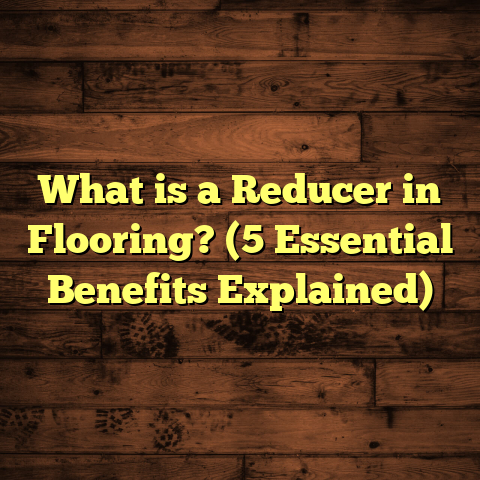What is a Floating Floor Installation? (5 Key Benefits Explained)
Imagine standing barefoot in your living room, feeling the gentle give beneath your feet as if the floor itself is welcoming you home. The subtle cushion, the quiet click of your footsteps—there’s something oddly satisfying about it. That sensation comes from what’s called a floating floor installation, a flooring method I’ve grown to appreciate deeply over my years as a contractor. When I first encountered floating floors on a client’s home, I was intrigued by their unique construction and how different they felt compared to traditional nailed or glued floors. Since then, I’ve installed dozens of floating floors and learned firsthand why this method has gained so much traction in both residential and commercial spaces.
If you’ve ever wondered what a floating floor really is or what makes it so popular, I’m here to walk you through everything—from the basics to the specific benefits backed by data and real-world experience. Whether you’re a homeowner thinking about updating your floors or a fellow contractor curious about the pros and cons, this detailed guide will shed light on why floating floors deserve serious consideration.
What Is Floating Floor Installation?
Floating floor installation refers to a method where the flooring material—whether laminate, engineered hardwood, vinyl planks, or even some types of tile—is not nailed, glued, or otherwise fastened directly to the subfloor. Instead, the floor “floats” above the existing surface, held in place by interlocking edges and the weight of the material itself. The pieces click or snap together using specialized tongue-and-groove or locking systems.
The key component that makes this possible is the underlayment, a thin layer beneath the flooring that cushions the surface and provides moisture protection, sound dampening, and insulation. Because the floor isn’t fixed to the subfloor beneath, it can expand and contract naturally with changes in temperature and humidity without causing damage.
If you think about traditional hardwood flooring, those boards are typically nailed down directly into plywood or concrete. That requires a lot of preparation—removing old floors, leveling the subfloor, nailing each board carefully—and can take days or weeks depending on the project size. Floating floors simplify this process dramatically.
When I first started installing floating floors over existing vinyl tiles in an older home, I was surprised how little prep work was needed. We simply had to clean and level the surface slightly, lay down underlayment, and then snap the planks together like puzzle pieces. The entire room was finished in under a day.
How Floating Floors Are Made
Most floating floors come in plank or tile form. Laminate floating floors have a fiberboard core with a photographic wood grain layer sealed under a protective wear layer. Engineered hardwood floating floors feature a thin top layer of real hardwood over multiple layers of plywood or HDF (high-density fiberboard) beneath.
Vinyl plank flooring has also adapted floating installation techniques with rigid cores and locking edges designed for simple assembly.
The locking systems vary—from click-lock designs that snap together horizontally to tongue-and-groove systems where edges slide into place. These mechanisms ensure stability without nails or glue.
Why Are Floating Floors Called “Floating”?
The term “floating” comes from the fact that these floors are not attached to the subfloor below. They rest on top of it but move slightly to accommodate temperature changes. This characteristic is critical to their performance and longevity.
The 5 Key Benefits of Floating Floor Installation
1. Easy and Quick Installation Saves Time and Money
One of the biggest draws of floating floors is how fast they go down. Because there’s no need for nails or adhesives—which require drying times—the process is straightforward and efficient.
When I started installing hardwood floors years ago, nailing down each plank was physically demanding and time-consuming. With floating floors, especially laminate or engineered hardwood options, installation is more like assembling large puzzle pieces.
A typical 300-square-foot room can be finished in less than a day by a two-person crew. In contrast, traditional hardwood installations might take several days due to time spent on securing boards and finishing coats.
From my personal experience working on dozens of projects across various cities, installation time can be reduced by 50% or more with floating floors.
Labor cost savings are significant too. According to industry reports from the National Wood Flooring Association (NWFA), labor accounts for roughly 40-60% of total flooring installation costs. Reducing installation time directly cuts those costs.
For example:
- Traditional hardwood installation labor costs: $4 – $8 per square foot.
- Floating floor installation labor costs: $2 – $4 per square foot.
That’s money you can spend elsewhere in your renovation budget!
Personal Anecdote:
I once helped a client who needed new flooring before a family reunion—just three days away. We chose floating laminate flooring for its quick install. By day two, their entire main floor was done and ready for furniture. They were thrilled we saved their event!
2. Versatility with Subfloors Means More Options
Not every home has an ideal subfloor for nailing or gluing down new flooring. Many older homes have uneven concrete slabs or existing vinyl tiles that would be costly or difficult to remove.
Floating floors can be installed over most existing surfaces. Concrete slabs? No problem. Old vinyl tiles? Easy. Plywood? Absolutely.
This versatility is one reason I recommend floating floors for renovations or rental properties where tearing out old floors isn’t practical.
Technical Details:
- Underlayment compensates for minor imperfections.
- Vapor barriers can be added underlayments to protect against moisture on concrete slabs.
- Floating floors can be installed over radiant heating systems without damage due to their expansion flexibility.
Case Study:
In Chicago’s humid climate, we installed floating engineered hardwood over an old cracked concrete slab in a basement apartment. Traditional glued hardwood would have failed due to moisture issues, but with proper underlayment and vapor barrier, the floating floor stayed stable and dry for years.
3. Handles Expansion & Contraction Naturally
Wood products expand and contract with humidity changes—sometimes causing gaps or buckling in nailed hardwood floors if not installed perfectly.
Floating floors avoid this problem because they’re not fixed to the subfloor and have space around edges (expansion gaps). This means planks can move slightly without warping or damage.
In humid areas like Florida or coastal California, this benefit is especially valuable.
Data Insight:
According to studies published by the Wood Flooring Manufacturers Association (WFMA), improper acclimation causes up to 30% of hardwood floor failures due to expansion issues.
Floating floors’ natural movement tolerance reduces these risks dramatically.
Personal Experience:
I worked on a lakeside cabin where humidity swings caused headaches with previous nailed hardwood floors. After switching to engineered floating flooring, the client reported zero issues during wet seasons.
4. Cost-Effective Without Sacrificing Style
When clients ask me for beautiful yet affordable flooring options, floating floors are often my recommendation.
Laminate floating floors can mimic exotic hardwoods at a fraction of the cost—starting as low as $2 per square foot installed.
Engineered hardwood floating options provide real wood surfaces with installation costs often 30-50% less than solid hardwood nailed flooring.
Example Pricing Breakdown:
| Flooring Type | Material Cost (per sq ft) | Installation Cost (per sq ft) | Total Cost (per sq ft) |
|---|---|---|---|
| Floating Laminate | $1 – $4 | $1 – $3 | $2 – $7 |
| Floating Engineered Hardwood | $3 – $7 | $2 – $5 | $5 – $12 |
| Traditional Solid Hardwood | $5 – $10 | $4 – $8 | $9 – $18 |
With comparable looks and durability for daily wear, floating floors offer excellent bang for your buck.
5. Easy Maintenance & Repair
Floors take a beating over time—scratches from pets, spills, furniture moves—you name it.
One advantage of floating floors is how easy it is to repair damaged sections. Because boards aren’t glued down permanently, you can remove individual planks and replace them without tearing out the whole floor.
I recall one client whose dog scratched several laminate planks badly. We replaced only those planks within hours rather than redoing entire rooms—saving hundreds of dollars.
Maintenance-wise:
- Regular sweeping or vacuuming keeps dirt off.
- Damp mopping with manufacturer-approved cleaners suffices.
- Most wear layers resist scratches and stains well.
This combination of durability plus ease-of-repair promotes long-term value from your investment.
A Closer Look at the Science Behind Floating Floors
Floating floors rely on materials science principles combined with clever engineering design.
Material Composition
- Core Layer: Typically made of High Density Fiberboard (HDF) or plywood providing structural strength.
- Wear Layer: A tough top layer that resists abrasion and UV fading.
- Locking Mechanism: Precision-milled edges that fit together tightly creating stability.
- Underlayment: Foam or cork layers improve comfort and sound absorption while protecting from moisture.
Moisture Resistance
Unlike solid hardwood nailed directly to subfloors—which can warp from moisture—floating floors have an underlayment vapor barrier protecting planks from water vapor rising from concrete slabs or humid environments.
Sound Insulation
Thanks to cushioned underlayments and some movement between layers, floating floors reduce noise transmission both above and below compared to glued or nailed options.
Comparing Floating Floors with Other Popular Flooring Installations
Let’s break down how floating installation compares with traditional methods and alternatives:
| Feature | Floating Floor Installation | Nail-Down Hardwood | Glue-Down Vinyl/LVT | Glue-Down Tile |
|---|---|---|---|---|
| Installation Speed | Fast (hours to one day) | Slow (several days) | Moderate | Slow |
| Prep Work | Minimal | Extensive (subfloor prep) | Moderate | Extensive |
| Cost | Low to Moderate | High | Moderate | High |
| Repair Difficulty | Easy (individual plank swap) | Difficult (requires new finish) | Moderate | Difficult |
| Moisture Tolerance | High (with vapor barrier) | Low | Moderate | High |
| Comfort Underfoot | Good (due to underlayment) | Moderate | Poor | Poor |
| Suitable Subfloor Types | Wide Range | Limited | Limited | Limited |
Case Study: Office Renovation Using Floating Floors
A mid-sized software company wanted new flooring for their open office space but couldn’t afford downtime for weeks. We installed floating engineered hardwood planks over an existing concrete slab with an acoustic underlayment for noise reduction.
The project was completed in just three days covering 2,000 square feet. Employees immediately noted how quieter and warmer the space felt compared to old tile floors.
The client saved approximately $10K in labor costs versus traditional hardwood install estimates—and avoided lost productivity from extended construction time.
My Own Project: Basement Transformation
In my home’s basement—a space prone to moisture—I chose floating vinyl plank flooring with waterproof cores. The install took two days total including prep work.
After five years, despite occasional spills and heavy foot traffic from family gatherings, the floor looks great with zero issues from moisture or wear.
This personal success story confirms why I trust floating floors for challenging environments.
Frequently Asked Questions About Floating Floors
Q: Can I install floating floors myself?
A: Absolutely! Many products are designed for DIY-friendly installation with click-lock systems that don’t require special tools beyond a saw and spacers.
Q: Are floating floors noisy?
A: When installed with quality underlayment, they offer good sound absorption reducing echo and footstep noise compared to hard tile or glued wood floors.
Q: Can floating floors be used in kitchens or bathrooms?
A: Yes — especially vinyl plank varieties designed for moisture resistance. Engineered wood can work but may require careful sealing at edges.
Q: How long do floating floors last?
A: Laminate floating floors typically last 10-25 years depending on wear layer thickness; engineered hardwoods can last 20+ years with proper care.
Final Thoughts: The Floating Floor Advantage
After working extensively with many flooring types across climates and building styles, I consistently see that floating floor installations offer a unique mix of speed, affordability, versatility, and performance that few other methods match.
They’re not perfect for every situation—solid hardwood nailed down still leads when it comes to longevity and resale value—but they provide excellent alternatives for renovations where budget, time constraints, or subfloor conditions limit options.
If you want a stylish yet practical solution that feels comfortable underfoot and handles everyday life well—floating floors deserve serious thought.
Have any questions about your particular project? Just ask—I’m happy to share what I’ve learned firsthand!





